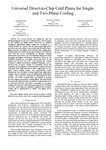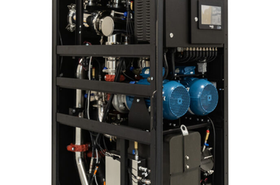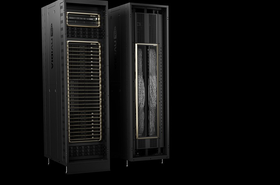Though the data center industry is currently focused on direct-to-chip liquid cooling, most of the world is still air-cooled. Thousands upon thousands of servers remain equipped with fans blowing cold air onto, and hot air away from, CPUs.
And though bleeding-edge GPUs have reached the point where air cooling is no longer feasible, air cooling is still the norm for many lower-density workloads and will continue to be so for years to come.
Spanish startup YPlasma is looking to offer a replacement for fans inside servers that could give air-cooling an efficiency and reliability boost. The technology essentially uses electrostatic fields to convert electrical current into airflow.
Launched in 2024, the company was spun out of the National Institute for Aerospace Technology (Instituto Nacional de Técnica Aeroespacial, or INTA) – the Spanish space agency part of the Ministry of Defence and described by YPlasma CEO David Garcia as Spain’s NASA.
The Madrid-based company’s technology uses plasma actuators, which it says allow for precise control of ionic airflow. Though interest in plasma actuators dates back to the days of the Cold War, they first left the lab in the 1990s, being used to improve aerodynamics.
The company’s actuator is called a Dielectric Barrier Discharge (DBD) and is composed of two thin copper electrode strips, with one surrounded by a dialectric material such as Teflon. The actuators can be between just 2-4 mm thick.
When you apply high voltage, the air around the actuator ionizes, creating plasma just above the dielectric surface. This can produce a controllable laminar airflow of charged particles known as ionic wind that can be used to blow cold air across electronics.
The direction and speed can be controlled by changing the voltage going through the electrodes. Garcia says the actuator’s ionic wind can reach speeds up to 40km per hour, or around 10 meters per second.
INTA’s technology was originally developed for aerodynamic purposes, with YPlasma initially targeting wind turbines. The actuators can be used to push air more uniformly over the turbine blades, producing more energy.
In the IT space, the company is looking at using its actuators to force air across chips, removing the need for fans. This could potentially save space and power, offering greater reliability than fan-based systems, and remoe vibrations, which could increase hardware lifespans. The company says its DBD actuators can match or exceed the heat dissipation capabilities of small fans.
This ionic wind, the company says, also removes the boundary layer air on electronics, allowing for better heat dissipation, resulting in natural heat convection combined with the forced convection of airflow over the chips. The cooling, it claims, can also be more uniform, eliminating hotspots.
YPlasma is currently working with Intel and Lenovo to look at using its plasma technology in laptops and workstations, but thinks there could also be utility within the server space.
Intel has been exploring ionic wind in chip cooling since at least 2022. Previously partnering with Purdue University in Indiana, the chip giant has filed patents for a plasma cooling heat sink that would use plasma-driven gas flow to cool down electronic devices
“We were curious if we were able to provide cooling capacity to the semiconductor industry,” says Garcia. “So we engaged with Intel. Intel has been doing research on plasma cooling, or ionic wind, for some years, so we were speaking the same language, and they asked if we could develop an actuator for laptop applications to cool down a CPU.”
“We started working with Intel in August (2024), and we developed a final prototype in January,” he adds. “In May or June, we will be ready to implement them in real laptops.”
Now, YPlasma is looking for a project partner to begin developing and proving out server-based products. Garcia has been in conversations with potential collaborators but is yet to secure a project partner.
“We’ve been exploring this space, and realizing that every single week we are able to pull down much higher demand in applications,” he continues. “We’ve seen that we can get higher levels of heat dissipation. And our objective is to evaluate if this technology is able to help in the data center industry. Perhaps not in the most demanding applications where liquid cooling is necessary, but there’s some intermediate applications where we can replace fans.”
In a talk at the OCP EMEA Summit in Dublin in April, YPlasma presented its aims in the data center space, saying it has been collaborating with “one of the main companies in the semiconductor industry” and that so far “all expectations have been exceeded,” with the system showing better performance than a regular cooling fan.
In early tests, the company says its actuators have been able to match or exceed the cooling performance of an 80mm fan under a 10W heat load. The actuators can also work below 0.05W, requiring less power than a fan to operate. A test video on the company’s website shows a chip being cooled from 84°C (183.2°F) down to 49°C (120.2°F).
As well as general cooling benefits. YPlasma claims its technology comes with added bonuses for data center firms. The company says plasma coatings can provide a barrier against corrosion and oxidation, protecting components from humidity and other environmental contaminants in high-humidity or industrial environments where equipment is more exposed to harsh conditions.
Plasma, it adds, can effectively remove contaminants such as dust, oils, and organic residues without physical contact or harsh chemical products. In dusty and dirty Edge deployments such as mines or factories, servers could benefit from fewer fans and cleaner air running through the systems.
Beyond the servers themselves, YPlasma thinks its technology could have application within the HVAC system. By ionizing the gas inside the heat exchangers, you could enhance the heat transfer coefficient.
The system can also produce heat instead of cold air, which could be used as a type of antifreeze; Garcia says it can generate heat up to 300°C (572°F).
And another potential use, the company suggests, is to create plasma-activated water, which can have a better heat transfer coefficient than regular water in liquid cooling systems. Research is still going on in this field. In the future, the company said it will be possible to combine actuators with AI algorithms, making it possible to optimize airflow control in real-time, automatically adapting to changing conditions.
Investors in YPlasma include SOSV/ HAX and Esade Ban, which both contributed to seed rounds totaling €1.1m ($1.2m) in 2024. Other investors include MWC’s Collider, and the European Space Agency’s Commercialisation Gateway.
Garcia was previously CEO of Quimera Energy Efficiency, a company that uses software to reduce energy demand in the hospitality sector; and immersive virtual reality firm Kiin. He says the company has recently closed another €2.5 million ($2.8m) raise.
Though Intel has been exploring the space for years, it isn’t the only company to have looked at plasma-based cooling for electronics. Apple filed a patent for an ionic wind cooling system back in 2012, but it’s unclear if the company ever took the idea further. Tessera, a chip packing company later renamed and broken out into Xperi Inc. and Adeia, demonstrated ionic wind cooling for a laptop in 2008 alongside the University of Washington.
YPlasma is not the only company that is looking at plasma for cooling today, and there could be a race to commercialize the technology. Ionic Wind Technologies, a spin-out from the Swiss Federal Laboratories for Materials Science and Technology (Empa), is also looking at developing its own ionic wind amplifier that could be used for chip cooling.
A bigger product than YPlasma’s and developed as a way to dry fruit, the company claims its custom-made needle tip electrodes achieve up to twice the airflow speeds compared to conventional electrodes and use less energy. The spin-off funding program Venture Kick and the Gebert Rüf Stiftung are providing financial support to the Empa spin-off as part of the InnoBooster program to bring the product to market maturity.
“We produce the airflow amplifiers ourselves and want to sell components in the future. However, as we have patents and other ideas, a licensing model could also be conceivable,” Ionic Wind founder Donato Rubinetti said in the company’s early 2025 launch announcement. “I see the potential wherever air needs to be moved with a small pressure difference. In future, however, above all in the cooling of computers, servers, or data centers.”
In the meantime, YPlasma’s Garcia says once the company finds a server-centric partner to collaborate with, it could have a working prototype on a specific application within six months.
“We just need to understand what the requirements are that we want to achieve,” he says. “It’s easy to build; we’ve got a lot of experience testing this.”
While it could be beneficial in some scenarios, the company does concede that its technology won’t be applicable to all chips within a data center. It is not, for example, aiming to compete with the densities liquid cooling is designed to cool, but can help remove fans in some air-cooled applications.
“We’re never going to have the capacity to remove as much heat as liquid or immersion cooling,” says Garcia, “but I think there’s a lot of heat we can remove without those technologies.”
More in IT Hardware & Semiconductors
Read the orginal article: https://www.datacenterdynamics.com/en/analysis/could-plasma-cooling-have-a-place-in-the-data-center/











